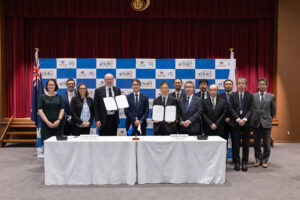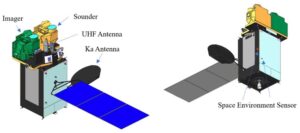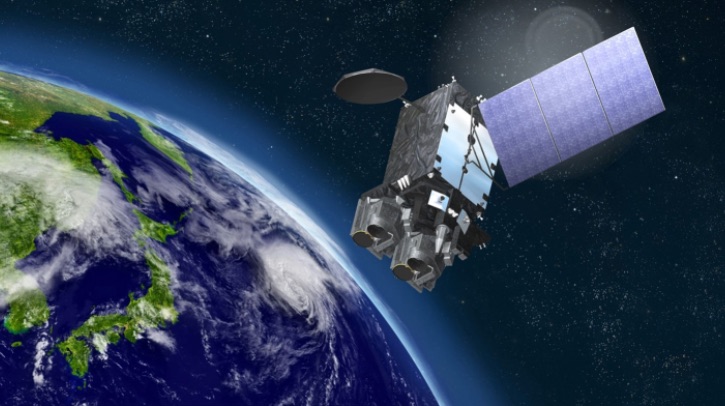The Bureau of Meteorology in Australia and the Japan Meteorological Agency (JMA) have signed a strategic relationship arrangement to enhance their longstanding collaboration on satellite meteorology and create more accurate and reliable forecasts and warnings.
High-impact weather across Asia-Oceania region
The arrangement, signed in a formal ceremony in Tokyo on November 11, 2024, is intended to increase community safety, support national security and enhance economic productivity.
Dr Andrew Johnson, CEO of the Bureau of Meteorology, was in Japan for the signing. He said, “The forecasts and warnings from the bureau that all Australians rely upon every day are critically dependent on the observations of Earth that we get from satellites – especially Himawari. Under the strategic relationship arrangement, the JMA will provide images of high-impact weather events every 2.5 minutes anywhere in the Australian region.”
Takashi Mori, director-general of JMA, commented, “It is my honor and privilege to sign this strategic relationship arrangement with Dr Johnson. Through this arrangement, the bureau and JMA will work together to leverage satellite Himawari data to further advance the meteorological services of both countries. I firmly believe that this collaboration will significantly contribute to disaster risk reduction activities to protect life and property, not only in Australia and Japan but across the broader Asia-Oceania region.”
In October 2022, the prime ministers of Australia and Japan announced an intention to strengthen cooperation between their governments to enhance Australia’s extreme weather and multi-hazard monitoring capabilities, with a focus on the successor to the Japanese geostationary meteorological satellite Himawari-9.
Himawari-10 satellite
In addition to extending a partnership that began between the two agencies in 1977, this agreement includes the opportunity to be part of the new Japanese Himawari-10 program. Himawari-10 is the successor to the Japanese geostationary meteorological satellite, Himawari-9, and will be delivered by 2029.
“This collaboration with Japan on the Himawari-10 satellite is Australia’s largest contribution to international meteorological satellite activities to date,” said Dr Johnson.
In 2023, Mitsubishi Electric Corporation won the contract from the JMA to build the Himawari-10, which will be the fourth such satellite to be built by the company, going back to the Himawari-7 over 20 years ago.
Himawari-10 will be equipped with a visible infrared imager and a hyperspectral infrared sounder, both built by L3 Harris Technologies of the United States, and a space environment sensor from the National Institute of Information and Communications Technology of Japan (NICT). The imager, which reportedly offers observation wavelength bands and resolutions superior to those of the Himawari- 8 and 9, will gather two-dimensional information about cloud and water-vapor distribution, and land, sea and cloud temperatures based on frequent measurement of visible to infrared rays emitted from Earth’s surface.
According to the supplier, Himawari-10 will be the first Japanese satellite to use a hyperspectral infrared sounder to gather 3D information about water vapor and atmospheric temperature by measuring infrared rays with high spectral resolution for improved forecasting of heavy and torrential rain as well as typhoon paths. The space environmental sensor will measure the intensity of proton and electron beams in space, which often are the cause of spacecraft malfunctions, to enhance forecasting reliability. The company also highlighted that the DS2000 is a highly durable and precise attitude stabilization system, and that the ground-data processing software for calibrating imager and sounder data maximizes sensor performance.

Himawari-10’s orbit design life is expected to be more than 15 years. The satellite’s bus mass is a DS2000 standard satellite platform with a mass of approximately 2.4t dry (without fuel) and approximately 6.1t wet (at launch). When the solar array is stowed, its dimensions are approximately 4 x 3 x 6m. (It is to be approximately 11m in width when the solar array is deployed in geostationary orbit.)
Today’s Himawari-9 satellite is situated 35,800km above the equator at longitude 140.7°E, above the western Pacific, in line with Japan, Papua and central Australia. This location enables the satellite to provide excellent coverage of the Australian region. High-definition images from the Himawari-9 satellite are available for viewing on the Bureau of Meteorology website.
In related news, the Australian Bureau of Meteorology (BoM) recently completed its seven-year Robust upgrade program, which involved the transformation of the bureau’s information and observing technology systems. Click here to read the full story.



